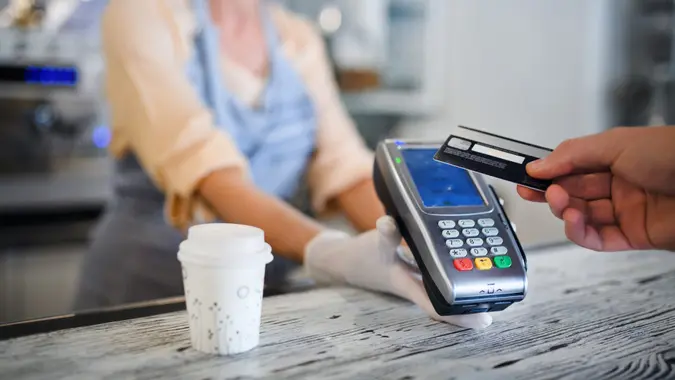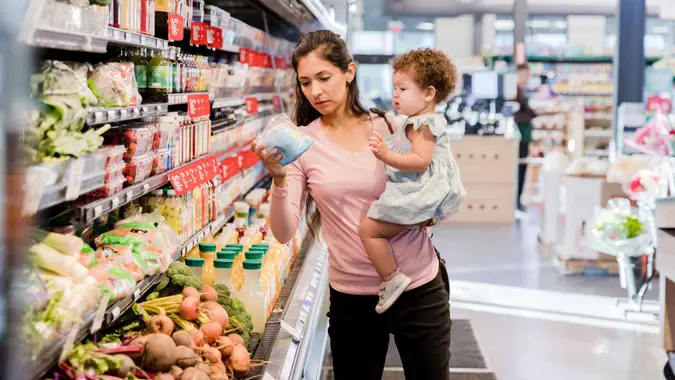This One Change To How You Grocery Shop Could Save You $70 Each Time

Commitment to Our Readers
GOBankingRates' editorial team is committed to bringing you unbiased reviews and information. We use data-driven methodologies to evaluate financial products and services - our reviews and ratings are not influenced by advertisers. You can read more about our editorial guidelines and our products and services review methodology.

20 Years
Helping You Live Richer

Reviewed
by Experts

Trusted by
Millions of Readers
Let’s admit to this one thing we’ve all done while shopping for groceries: paying for convenience. We’ve bought the pineapple already cut into chunks to save prep time, picked a hot entrée from the store’s deli instead of cooking, and chosen to buy two dozen cupcakes for our kids’ bake sale rather than buy a box of mix and a tub of frosting.
Because it’s all just easier. Even if it costs more.
But in 2020, during the COVID-19 pandemic, an epic shift happened in how we shopped. Many of us, hesitant to go to the supermarket or big-box store, turned to the growing shop-from-home industry. Health and safety concerns lessened when we could open the store’s app, fill our virtual shopping carts and have a masked person we’d never need to make contact with drop bags filled with food, medicine, cleaning supplies and anything else we needed by the front door.
And our attachment to online shopping hasn’t waned since the end of the pandemic. A study by Capital One Shopping showed that 28 percent of American adults buy groceries online at least once a month. In 2025, online grocery sales are projected to increase to as much as $221 billion, up from $159 billion in 2023.
Is online shopping busting our budgets, however? GOBankingRates set out to find the answer.
Filling the Online Cart
It sure is easy to fill your shopping cart from the comfort of your home, sitting on the couch and making your purchases through clicks on an app. However, at many stores across the country, you’re paying a little extra for each item you buy. Your favorite store’s website probably contains a memo stating prices may vary from those available in-store. But just how much more could you be paying?
We did some online shopping at the website of a national retailer, “buying” common household items that included ingredients for a variety of home-prepared meals; things you don’t buy every week, ranging from ketchup to laundry soap; dog food; paper products; dairy products; fresh baked goods; and more.
In all, our cart contained 66 popular items that totaled $252.22 before sales taxes.
Walking the Aisles
Armed with the shopping list of the exact items in the virtual cart, we went to the brick-and-mortar store to check the variation of prices. All 66 items were in stock, and we recorded the price from the shelf on a spreadsheet.
The price of three items registered the same, whether online or in-store. With the other 60, the online price rang higher, with various differences. Six cents here, 16 cents there, 20 cents, 46 cents, even more than $1 on some goods.
The 66 products added up to $229.67 before taxes. That’s $22.55 less for someone who shops in a store rather than buying online for home delivery.
But, Don’t Forget These Costs
That $20 bill and change might be worth having someone else fulfill your shopping list and bring it to your doorstep. But the difference rings in at more than that.
Our virtual order included a delivery fee of $4, a service fee of about $18 and a 10% tip for the delivery person – about $25. With these additional fees of approximately $47, that $22.55 difference in online vs. in-store shopping grew to about $70.
Cutting the Cost
You have a few cost-saving options if you’re now committed to online grocery shopping only.
Start by moving that delivery order to curbside pickup. Instead of the delivery fee, service fee and tip, our test store charged just $2 for you to come to the store to claim your order. It’s worth asking at your local supermarkets about their fees for online shopping, whether you’re picking it up or having it delivered.
Or, subscribe to a service that offers free delivery or curbside pickup on groceries for one up-front fee. Those include Walmart+, which costs $12.95 per month for unlimited free delivery on orders of at least $35, along with other cost-saving benefits, and Instacart+. With the latter, you’ll pay $9.99 a month for no-fee delivery as well as reduced service fees and other perks.
More From GOBankingRates
- Nearly 1 in 3 Americans Hit by a Costly Holiday Scam, Norton Survey Shows -- How To Avoid This
- Here's What Retirees Wasted the Most Money On in 2025 -- and How To Avoid It in 2026
- How Middle-Class Earners Are Quietly Becoming Millionaires -- and How You Can, Too
- 6 Safe Accounts Proven to Grow Your Money Up to 13x Faster
 Written by
Written by  Edited by
Edited by 

























